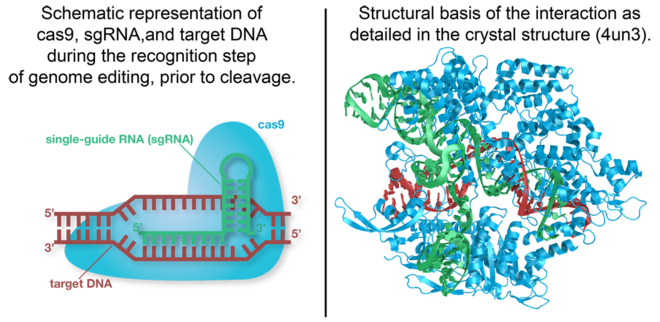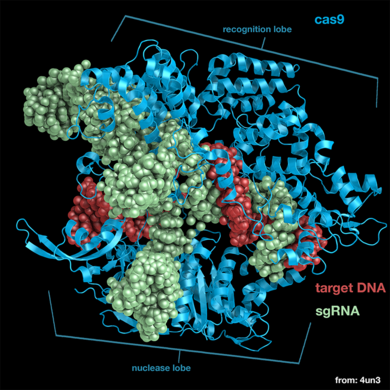Cas9 Sandbox
From Proteopedia
(Difference between revisions)
| Line 1: | Line 1: | ||
[[Cas9]] is the RNA-guided [[DNA]] [[endonuclease]] used by the CRISPR (clustered regularly interspaced short palindromic repeats)-associated systems to generate double-strand DNA breaks in the invading DNA during an adaptive bacterial immune response. | [[Cas9]] is the RNA-guided [[DNA]] [[endonuclease]] used by the CRISPR (clustered regularly interspaced short palindromic repeats)-associated systems to generate double-strand DNA breaks in the invading DNA during an adaptive bacterial immune response. | ||
| - | <Structure load=' | + | <Structure load='<scene name='71/714945/Pam_interaction/1'>CAS9</scene>' size='350' frame='true' align='right' caption='Insert caption here' scene='Insert optional scene name here' /> |
The CRISPR-associated endonuclease [[Cas9]] has been exploited for use in genome editing systems. In such systems, an engineered single-guide RNA (sgRNA) is used to target double-stranded breaks in genomic DNA. Depending on what repair pathway is triggered, often dictated by the inclusion of additional engineered components, the targeted site either is disrupted or incorporates additional genetic sequences. | The CRISPR-associated endonuclease [[Cas9]] has been exploited for use in genome editing systems. In such systems, an engineered single-guide RNA (sgRNA) is used to target double-stranded breaks in genomic DNA. Depending on what repair pathway is triggered, often dictated by the inclusion of additional engineered components, the targeted site either is disrupted or incorporates additional genetic sequences. | ||
Revision as of 13:05, 6 October 2015
Cas9 is the RNA-guided DNA endonuclease used by the CRISPR (clustered regularly interspaced short palindromic repeats)-associated systems to generate double-strand DNA breaks in the invading DNA during an adaptive bacterial immune response.
| |||||||||||


